Some interesting tidbits can be gleaned from the BEA’s recent release. First, despite the acceleration in growth in 2007Q2, the level of output in 2007Q2 is less than what we thought — as of 28 June — it was in 2007Q1. Second, q/q consumption growth now looks weaker than it did before. Third, while net exports provided a big boost to GDP growth, a large chunk of that effect is attributable to import compression, rather than export acceleration. How one views the durability of the net export effect depends in large part upon how one views the sources of import and export trends.
Figure 1 shows the revisions to GDP growth. Figure 2 illustrates the impact of these downward growth revisions on the level of GDP.
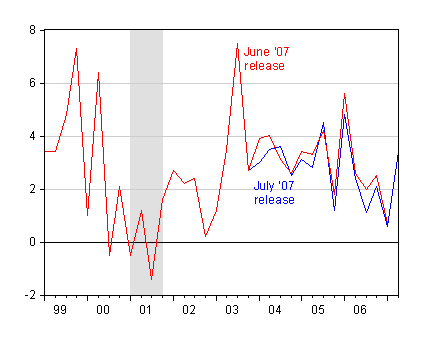
Figure 1: Quarter on quarter GDP growth, SAAR, from July 27 (blue) and June 28 (red) releases. NBER-defined recessions shaded gray. Source: BEA, and NBER.
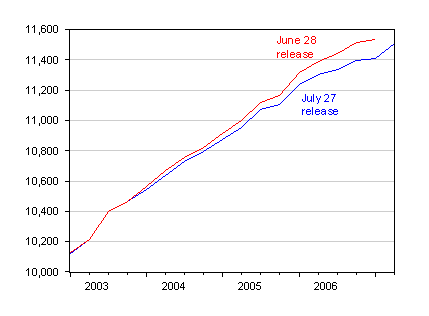
Figure 2: Real GDP in billions of Ch.2000$, SAAR, from July 27 (blue) and June 28 (red) releases. NBER-defined recessions shaded gray. Source: BEA, and NBER.
The level of GDP in 2007Q2 is less than what we thought it was in 2007Q1 as of the June 28th release. This perhaps doesn’t matter much in the sense that one is interested in the momentum of the economy. However, to the extent that one is concerned with how many goods and services are available at a given point in time, it is. (And actually, it matters for momentum to the extent that one thinks log GDP is trend-stationary as opposed to difference stationary).
While my focus is on the international aspects, to the extent that some of the import growth has been driven by above average consumption to GDP levels, it seems important to pay attention to what this is doing. And consumption growth is apparently weakening — indeed the revision indicates that even last quarter’s blockbuster consumption growth figures were less impressive than earlier thought.
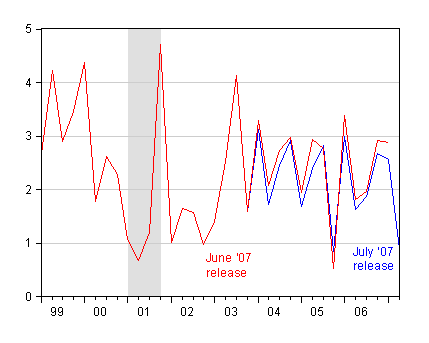
Figure 3: Contribution of personal consumption to GDP growth in percentage points, SAAR, from July 27 (blue) and June 28 (red) releases. NBER-defined recessions shaded gray. Source: BEA, and NBER.
The slowdown in Q2 is not unprecedented, and the demise of the American consumer has been so often predicted that I’d be wary of doing it here, but I would say that consumption seems to be signalling a slowdown in overall economic growth. (By the way, an increase in household saving measured in flow terms is usually one of those things that presage an income slowdown.)
I also focus on this issue because it relates to the trade balance’s role in the Q2 growth.
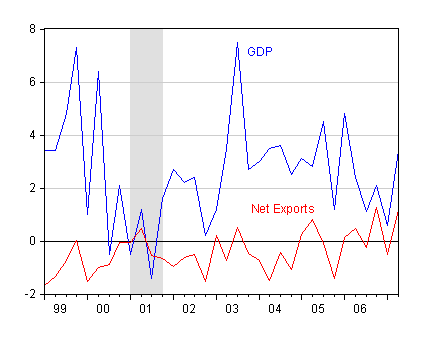
Figure 4: Contribution of net exportsto GDP growth in percentage points, SAAR, from July 27 (blue) and June 28 (red) releases. NBER-defined recessions shaded gray. Source: BEA, and NBER.
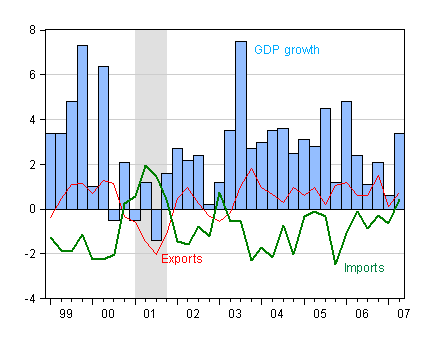
Figure 5: Contribution of exports (red) and imports (green) to GDP growth (blue bars) in percentage points, SAAR, from July 27 (red) release. Source: BEA.
Figure 5 highlights the contribution of net exports to real GDP growth. It’s clear a lot of the growth is attributable to this component of aggregate demand. Breaking down the net export effect into imports and exports, it also becomes apparent that — while changes in both components had about equal importance — the big story is the fact that imports have gone from a negative effect to a positive one (see this post for an earlier discussion of this point).
Figure 6 highlights the fact that while exports are growing at a trend 7.15% per annum, the closing of the trade gap is being driven by the reduction of real imports of goods and services. Then the question is whether import compression is due to expenditure switching (in my view, a positive development), or expenditure reduction.
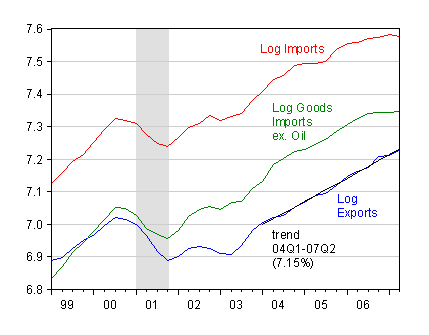
Figure 6: Log real exports (blue) and 04Q1-07Q2 linear trend, imports (red) and non-oil goods imports (green) in billions of Ch.2000$, SAAR, from July 27 release. NBER-defined recessions shaded gray. Source: BEA, NBER and author’s calculations.
If the reduction of imports is due primarily to a collapse in consumption, this is probably not the best outcome. My preference would have been for smooth transition to a greater share of the economy originating the production tradables, and a very gradual slowdown in consumption. That might have been possible with a less expansionary tax policy (think 2003 tax cut — was it really necessary?), more prudential regulation, and perhaps even some hint that a rescission of the 2003 tax cuts was possible. But, as I pointed out last year, by now too many things are “baked in the cake”.
Personally, my guess is for a pretty rapid adjustment in the trade balance, much less marked adjustment in the current account and, like Nouriel Roubini, a really noticeable slowdown in economic growth in 2007H2.
Technorati Tags: net exports,
trade deficit,
dollar,
exchange rate,
GDP,
recession.
should lower deficits help crushed USD?
i have serious doubts.
Nice analysis, Professor. Lots of work! Thank you.
What’s the emoticon beyond frown?
Menzie wrote:
That might have been possible with a less expansionary tax policy (think 2003 tax cut — was it really necessary?), more prudential regulation, and perhaps even some hint that a rescission of the 2003 tax cuts was possible. But, as I pointed out last year, by now too many things are “baked in the cake”.
There has been much analysis done to “prove” that tax cuts do not pay for themselves, but have you seen any analysis that proves a tax increase pays for itself? It is not difficult to look at the results of tax increases to see that they are followed by reduced economic activity, increased unemployment and ultimately reduced tax receipts.
At one time there was debate over tax rate increases and their prudence concerning increased tax receipts. Today the argument has been turned on its head. We debate “a rescission of the 2003 tax cuts.”
I feel totally confident with what I have see and studied that when the Democrat congress allows the tax cuts to expire economic decline will follow.
What emotocon is beyone a frown? How about one pushing a wheelbarrow full of money from the unemployment office to the IRS office.
Sir-
I thought I saw something in that report about a revision to the national savings rate. I was wondering if you saw that as having any significance? Thanks
Dick F.
Tax receipts as a percentage of GDP has been much higher in the past with faster economic growth happening at the same time. The 80’s and 90’s are just two examples. Where you get your theory from, I don’t know, but it seems pure ideology.
great analysis of the contribution trade is making to GDP growth. With oil at close to $80, i think you probably do need very very slow GDP growth tho to bring the (nominal) trade deficit down — so i am a bit less inclined to forecast a major fall in the (nominal) trade deficit.
The Bush era economy has only ever grown at trend growth. Nothing impressive. Q3 96-Q2 2000 this hasn’t been. Nor has it been 87-H1 1989 either during the post-recovery expansion booms. Both periods saw above trend growth thus booms in the labor market. We have had no boom. If it wasn’t for the “survey” and error prone models of BLS, this era of economy wouldn’t be as highly touted. Much like in the late 80’s when the BLS overestimated the labor force causing unemployment to be projected higher, this decade the labor force has been underestimated thus lower projections of unemployment. The FED tried to put pressure on the BLS though, which was a warning shot.
What it means to future growth is that a weaker economy means a faster dip into recession once the support goes away. For the last year now growth has slowed to below trend which can’t last forever. Either it goes back up or it contracts. I don’t see a middle ground.
Professors,
I have a question. Why are gas prices and oil prices diverging since April? Are folks driving less or the economy is slowing and oil has not caught up? Or non-US demand has picked up significantly?
You can find the chart at gasbuddy.com (under the historic price charts).
thanks,
Naushik
http://66.70.86.64/ch.gaschart?Country=Canada&Crude=t&Period=36&Areas=USA%20Average,,&Unit=US%20$/G
Naushik, gasoline prices had earlier been rising relative to crude because of strong summer gasoline demand confronting problems at a number of refineries, exacerbating the normal tendency of gasoline prices to rise relative to crude during the spring. With those refinery problems behind us, gasoline prices have been easing even though crude is hitting new highs. (Sorry to drift off topic, Menzie).
Jack wrote:
Tax receipts as a percentage of GDP has been much higher in the past with faster economic growth happening at the same time. The 80’s and 90’s are just two examples. Where you get your theory from, I don’t know, but it seems pure ideology.
Jack,
Just think about the period you choose an your example. What makes the 1980s unique? The supply side effects the were experienced in the 1980s spilled over into the 1990s and Bill Clinton’s populist actions concerning the economy continued the prosperity. We are still today reaping benefits from the supply side changes in the 1980s. Don’t even think that an economic decision only lasts 1 or 2 years. Property, plant, and equipment have long lives and consider long term contracts.
As JDH points out the problem is refining. In the spring refinery shutdowns, etc, caused refining capacity utilization to contract. This allowed refiners to expand margins and raise gas prices even though crude prices were flat. Now, the refineries are back on line, capacity utilization and refining margins are falling, offsetting the rise in crude. But this process should have run its course now and the normal tight fit between crude and gas prices should be reestablished.
Often we seem to miss the obvious. Consider the note below sent to me by a friend.
Dick, I was spooked into the posture … by listening to recent conference calls. I listened to the Caterpillar Conference call which explained that the company was dealing with “Two Worlds”…a declining North American market and an expanding Rest of the World (ROW), market. Caterpillar sold off because they were too exposed to the North American market for equipment in construction and large trucks, where demand is collapsing. (43% of their business)…and although they had record growth in the ROW (53% of their business); they lacked capacity to exploit that demand without contracting margins. I heard the same thing from Cummins, Eaton, and United Technologies. If you look at the sell off in stocks, the issue is about North American exposure vs. ROW business. How can anyone see what is happening and not ask why the U.S. is not growing….why are we not worried that China will source its infrastructure purchases from European companies instead of U.S. Companies….why are we not worried that Asian growth will abate and knock another leg off our three legged economy? Paulson points out that we have the highest corporate taxes in the world, that SarBox drives our financing business to London, and politicians hardly deal with the issue except to deny the implications like a bunch of ostriches. It’s clear that there is no integrity in our elected houses. They pass an obscene agricultural subsidy bill when farm product prices are at a high….they ignore any meaningful energy bill when production of oil world wide is declining….listen to the Exxon conference call…their production is down even though the oil price is up. What do we do to encourage production?…mix it with subsidized corn and let the poor eat cake?…it goes on and on…pandering for votes while the U.S. declines.
Dick F.
you wrote
“why are we not worried that China will source its infrastructure purchases from European companies instead of U.S. Companies….”
b/c as you may have noticed this year the dollar has plunged against the euro. Since the yuan is roughly pegged to us dollar, capital equipment has become much more expensive for Chinese to buy from europeans. Hence the strong demand seen by US companies (Caterpillar, GE, UTC, etc)
folks, we are going to get through this slow patch just fine, that is until we hit the next batch of turbulence and then the real recession hits
Thanks to JDH for stepping in to answer the gasoline/oil question.
DickF: You seem to have a particularly malleable view of lags in terms of tax cuts and subsequent economic activity and revenues. Where do you get your estimates of lag structures? I seem to recall you didn’t believe in econometrics.
Menzie,
I have no problem with econometrics when it is used in an imaginary ceteris paribus world. My problem with econometrics is when the econometrics drives the economics. Economics must progress from the micro to the macro. Making decisions in the aggregate can knock the stuffings out of the micro and then those who live only in the macro world began to scratch their heads when the numbers look strange.
You are correct that I have a particularly malleable view of lags because economics does not take place in a vacuum of a couple of years. A few very different, yet significant, examples:
The income tax has been influencing economics since 1913.
Nixon’s closing of the gold window in 1971 threw monetary theory for a loop.
The Supply side economics of Ronald Reagan changing the tax rate structure has influenced US economics for over 20 years giving us one of the longest sustained growth periods in US history.
Another more current example is the influence of the personal computer and the internet putting productivity, especially in the 1990s, into hyper-drive.
Each such change significantly changes economics.
The econometrics will change, but the basics do not; man’s drive to ease his discomfort and the scarcity of solutions will always drive economics.
Perhaps it will help if I say that I do agree with Hazlitt’s Economics in One Lesson.
Kevin,
Understand that international trade is much more than exchange rates. As my friend pointed out Paulson has told us we have the highest corporate taxes and SarBox and other regulations on corporations are driving our financing business overseas.
It is not rocket science to understand that if a company can reduce cost and increase sales by moving to another country it will happen. We can march in every “Buy America” parade that happens and it will not change the basic economic reality.
Unless congress begins to see that it is making the production environment in the US less and less friendly we will continue to lose our world market share. It is not going to happen tomorrow but do not lose sight of the fact that China just replaced Germany as the 3rd largest economy in the world.
The rest of the world from Ireland to the Balkans are learning how to compete with better tax policy and a better production environment. Remember the UK was the world economic leader for centuries, but they lost their place to the US. We have been the world economic leader for a little less than 100 years. Will we give way as did the UK?
The evidence is that we are headed in the wrong direction. I am less an alarmist than a watchman at the door giving a warning. But if the warning is not heeded the alarm will sound. The question is, will it be too late?
Economic potential growth (in the lonbg run) is predefined http://ikitov.blogspot.com/2007/05/modelling-real-gdp-per-capita-in-usa.html